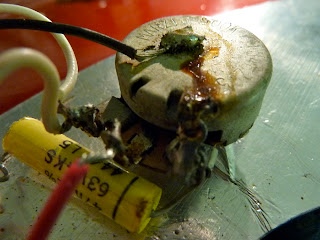In the previous post I pointed out where the body cavity near the switch was sanded dangerously thin. While I won't divulge how the hole was patched (it's a surprise), I will show how it has been reinforced.
Inside the body cavity was a recess machined further into the surface to accommodate the 5-way switch. With the body sanded thinner, the recess is no longer required and the remaining surface is only about 1mm thick. The recess is deep enough to fit two layers of mahogany veneer, so I'll cut them to shape with the grain alternating direction for added strength.
A straightforward technique that I remember from elementary school art class! Capturing the outline of the recess on some tape, then transferring it on to the piece of veneer, with some careful cutting and sanding will achieve a form-fitting piece.
Under the tape is the veneer. The main concern now is to ensure adhesion in the edges but avoiding direct pressure near the weakened slot that houses the sliding switch.
A new control cover was also required. Sanding off the original finish left the cavity too shallow to accommodate a new plastic control plate, so the area will have to be milled down. A Dremel with cutting wheel and an improvised jig will get it started.
Now to make the control plate. A much cheaper option than ordering a pre-feb one for this discontinued model.
Once again transferring the traced outline, this time on to a sheet of black pickguard plastic. After a trip to the bandsaw and belt sander and some tweaking with a sanding block, this dropped right in to place.
Now to align the holes. Many people would simply drill new ones and fill the old ones, but the time it takes to transpose the location of the original holes is about the same.
Painter's tape has been my best friend on this project!
Aligning the pencil marks with the corresponding corner allowed pinpoint accuracy for the screw holes.
Countersunk and ready for the finishing touches! More updates on this project to come!



















































